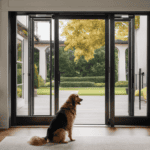Are you ready to transform your entryway into a stunning masterpiece?
Well, buckle up because we’ve got the ultimate guide on how to build a door jamb for French doors.
It’s time to say goodbye to those pesky drafts and hello to energy efficiency and style.
With a bit of precision and attention to detail, you’ll have a secure and functional door jamb that will make your neighbours green with envy.
So, let’s dive in and get those French doors shining!
Key Takeaways
- French doors enhance the aesthetic appeal of a home and provide natural light and improved air circulation.
- Precise measurements and cuts are necessary for a proper fit when cutting and assembling the door jamb.
- Jamb sealing techniques and weatherstripping are important to prevent air leakage and improve energy efficiency.
- Proper measurements, effective use of wood glue, and avoiding common mistakes are crucial when building a door jamb for French doors.
Introduction
So, you’re interested in learning how to build a door jamb for French doors?
French doors are an excellent choice for those looking to enhance the aesthetic appeal of their home while enjoying the benefits of natural light and improved air circulation.
Different types of French doors are available, including hinged and sliding options, allowing you to select the style that best suits your needs and preferences.
When building a door jamb for French doors, it is crucial to choose the right size to ensure a proper fit.
Additionally, regular maintenance is essential to keep your French doors in optimal condition, and weatherstripping can be used to improve energy efficiency and prevent drafts.
Materials Needed
You’ll need lumber, wood glue, screws, and weatherstripping to construct the jamb for your French doors.
Start by measuring the dimensions of your door frame to ensure a precise fit. Cut the lumber accordingly, ensuring each piece has the correct length and width.
Next, assemble the jamb pieces using wood glue and secure them with screws for added durability. This will create a strong and stable frame for your French doors.
Once the jamb is assembled, install it securely in the door opening, ensuring it is square and level for proper door functionality.
Tools Needed
Grab your saw, tape measure, level, and drill – these tools are essential for constructing the jamb for your doors.
To ensure a proper fit, start by taking precise door opening measurements. Cut the lumber to the appropriate dimensions, accounting for the width of the jamb and any desired reveals.
Assemble the jamb pieces using wood glue and screws for added durability. Once the jamb is assembled, seal and install it securely before hanging the doors. Don’t forget to install weatherstripping to improve energy efficiency and prevent drafts.
Ensuring that the jamb is square and level is crucial, as this will guarantee the proper door functionality. So, take your time and use the necessary tools to create a well-built and functional door jamb.
Cutting the Lumber
Start by carefully measuring and cutting the lumber to the appropriate dimensions for the jamb of your doors. This is a crucial step in ensuring your French doors’ proper fit and functionality.
Here’s a step-by-step guide to help you through the measuring and cutting process:
- Measure the height and width of your doors, including the jamb thickness. Use a tape measure to get accurate measurements.
- Choose the right lumber type for your jamb. Standard options include pine, cedar, and oak. Consider the durability and aesthetic appeal of each type.
- Use proper cutting techniques to ensure clean and precise cuts. A circular or mitre saw can cut the side jambs, head jamb, and bottom jamb.
- Take into account the jamb thickness when cutting the lumber. This will determine the door opening size and how the doors will fit within the jamb.
Assembling the Door Jamb
After cutting the lumber, attach the side jambs to the head jamb using wood glue and screws. This step is crucial in ensuring the stability and durability of the door jamb. Proper measurements are essential to ensure that the jambs fit snugly and securely. When choosing the suitable wood for the jamb, opt for a high-quality, sturdy material that can withstand the test of time. Secure the jamb using wood glue and screws at strategic points to ensure a strong bond. Additionally, consider attaching hardware such as hinges and handles to enhance the functionality and aesthetics of the doors. Finally, don’t forget to explore weatherstripping options to maximize energy efficiency and prevent drafts. A well-assembled door jamb is the foundation for a beautifully constructed set of French doors.
| ATTACHING HARDWARE | PROPER MEASUREMENTS | CHOOSING THE RIGHT WOOD |
|---|---|---|
| Hinges | Accurate dimensions | High-quality material |
| Handles | Precise angles | Sturdy and durable |
| Locks | Snug fit | Resistant to elements |
Installing the Jamb
To ensure proper installation, ensure the jamb is securely sealed to prevent moisture damage. Proper jamb installation is crucial to the functionality and longevity of your door. Here are some essential tips to consider:
- Importance of appropriate jamb installation:
- A well-installed jamb provides stability and support for the door.
- It helps maintain a tight seal, preventing drafts and energy loss.
- It enhances the overall appearance and aesthetics of the doorway.
- Common mistakes to avoid when installing a door jamb:
- Neglecting to measure accurately, resulting in a misaligned jamb.
- Failing to use wood glue and screws for secure assembly leads to instability.
- Overlooking the importance of sealing the jamb, which can cause moisture damage.
- Tips for ensuring a square and level jamb:
- Use a level and square to check for accuracy during installation.
- Adjust the jamb as needed to ensure it is perfectly square and level.
- Double-check measurements to avoid any discrepancies.
- How to properly attach the jamb to the wall:
- Use a combination of screws and nails to secure the jamb to the framing.
- Ensure that the jamb is tightly pressed against the wall.
- Add shims as necessary to achieve a snug fit and prevent any movement.
- Benefits of using weatherstripping in jamb installation:
- Weatherstripping helps create a tight seal, preventing drafts and energy loss.
- It reduces noise transmission and enhances soundproofing.
- It provides an added layer of insulation, improving energy efficiency.
Following these tips and techniques will ensure a proper and secure installation of your door jamb, resulting in a functional and aesthetically pleasing doorway. Proper jamb sealing techniques are crucial to prevent drafts and energy loss. By using weatherstripping, you can enhance the energy efficiency of your French doors and reduce utility costs. It is also essential to take accurate measurements to ensure a perfect fit and eliminate gaps. When assembling the jamb, use wood glue effectively to create a solid and durable bond. Avoid common mistakes such as rushing the installation or neglecting proper levelling. By following these guidelines and paying attention to detail, you can successfully build a door jamb for your French doors that will provide long-lasting performance and enhance the overall appearance of your home.
| Jamb Sealing Techniques | Benefits of Using Weatherstripping | Importance of Proper Measurements |
|---|---|---|
| Use caulk or weatherstripping tape to seal gaps and prevent air leakage | Reduces energy loss and lowers utility costs | Ensures a proper fit and eliminates drafts |
| Apply adhesive-backed weatherstripping along the door stop to create a tight seal | Prevents drafts and keeps out dust and insects | Ensures energy efficiency and comfort |
| Install a door sweep at the bottom of the jamb to block drafts and improve insulation | Enhances energy efficiency and reduces noise | Prevents air infiltration and increases energy savings |
| Tips for Using Wood Glue Effectively | Common Mistakes to Avoid when Installing a Door Jamb |
|---|---|
| Apply an even layer of glue to both surfaces being joined | Rushing the installation process |
| Use clamps or weights to hold the pieces together while the glue dries | Neglecting to check the level and squareness of the jamb |
| Wipe away any excess glue before it dries | Failing to use screws in addition to glue for added strength |
| Allow the glue to fully cure before subjecting the jamb to stress or weight | Not sealing gaps and cracks properly |
| Follow the manufacturer’s instructions for drying time and temperature | Ignoring the importance of weather-resistant lumber |
What type of door jamb is best for French doors and their hardware?
When choosing the best type of door jamb for French doors and their hardware for french doors, it’s important to consider durability and stability. Opt for solid wood door jambs to support the weight and hinges of the doors, and ensure that the hardware is compatible with the jamb for seamless installation.
Frequently Asked Questions
How Do I Determine the Size of the Door Jamb Needed for My French Doors?
To determine the size of the door jamb needed for French doors, we measure the width and height of the door opening. We then cut and assemble the jamb materials, secure them in place, and finish them for a professional look.
Can I Use a Pre-Made Door Jamb Instead of Building One From Scratch?
A pre-made door jamb can be used instead of building one from scratch. However, building from scratch offers benefits like customization options and a potentially lower cost. The installation process remains the same.
Is It Necessary to Use Wood Glue and Screws to Assemble the Door Jamb, or Can I Use Just One of These Methods?
Using wood glue or screws alone to assemble the door jamb may compromise its durability. Combining both methods provides a more robust and more secure jamb. It is recommended to follow expert opinions for optimal results.
What Type of Weatherstripping Is Best for French Doors?
For French doors, the best weatherstripping depends on factors like door material and climate. Options include adhesive-backed foam, V-strip, and magnetic weatherstripping. Proper installation ensures energy efficiency and reduces drafts.
How Do I Ensure That the Door Jamb Is Square and Level Before Installing the Doors?
To ensure a square and level door jamb, we use measuring tools like a square and a level. We check for squareness by measuring diagonals and adjust uneven jambs by shimming or planning.
Reference links:
https://youtube.com/watch?v=lvv3RlfXe1U
https://youtube.com/watch?v=ro18C5xoU3Y
https://youtube.com/watch?v=vNDDXrpcj0Y
https://www.finehomebuilding.com/forum/fabricating-exterior-french-door-jamb
https://www.hunker.com/13401541/how-to-build-a-door-jamb-from-scratch
https://www.instructables.com/Building-Frame-Panel-French-Doors/








